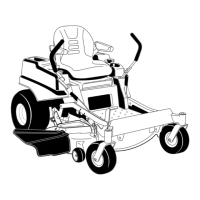ELECTRICAL
7-11
Toro TITAN 2009-2013 Service Manual
7
A
B
D
C
Fig. 153 clutch current msmt_v2
PTO Clutch Electrical Specications
Ohms
Specication
Amp Draw
Specication
Continuity
to Ground
2.84 + 15% 4.23A + 15% OPEN
PTO Clutch Continuity to Ground Check
1. Disengage PTO switch, turn ignition off and remove
key.
2. Disconnect clutch wire connector.
3. Set the multimeter to check resistance (ohms).
4. Connect one meter lead to the engine, chassis or
battery ground. Connect the other meter lead to
each of the PTO clutch terminals.
5. The two PTO terminals should never have continuity
to ground and should be OPEN at all times.
If continuity is found between the clutch wires
and ground, the clutch and PTO switch must be
replaced.
Measuring Clutch Current Draw
Note: Do not measure current draw if clutch
has shorted to ground or if the resistance
measurement is out of specication.
1. Disengage PTO switch, turn ignition off and remove
key.
2. Disconnect clutch wire connector.
3. Set the multimeter to check amps (10 amp scale).
4. Connect the positive meter lead to the chassis
harness terminal A (brown wire) (Fig. 153).
5. Connect the negative meter lead to the correspond-
ing wire terminal B (Fig. 153).
6. Connect a short jumper lead from terminal C to
terminal D (Fig. 153).
7. Turn the ignition key in the switch to “RUN” position
and the PTO switch to the “ON” position.
8. See the PTO Clutch Electrical Specications chart.
PTO Circuit & Operation
The The PTO clutch is powered by the PTO Switch and
grounded through the kill relay.
The PTO Clutch will only ground and engage when:
- The ignition switch is in the ON position.
- The PTO switch is in the ON position.
- Proper battery voltage is present at the key switch
kill relay.
- Proper ground is present at the battery, chassis
and kill relay.
- An operator is in the seat.
- The parking brake is ON and the handles are in
the outward neutral position.
- The parking brake is OFF and the handles in any
position.
Note: The engine will not crank over to start when
the PTO switch is ON.
(Fig. 154, next page)

